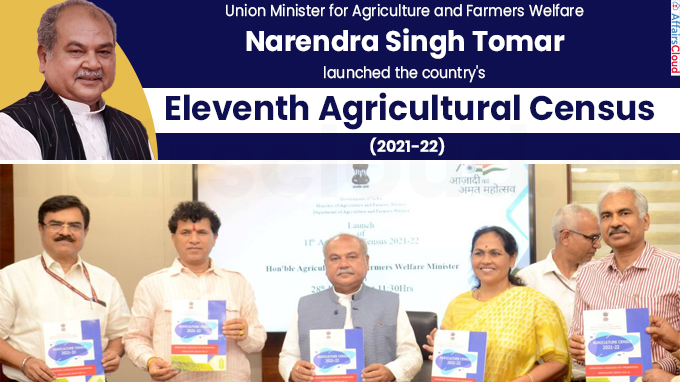
The Eleventh Agricultural Census (2021–2022) has been launched by Union Minister Narendra Singh Tomar, Ministry of Agriculture & Farmers Welfare (MoAFW) to collect data on a variety of parameters, including operating holdings. For the first time, data will be collected using smartphones and tablets.
- The fieldwork for the Eleventh Agricultural Census (2021-22) will commence in August 2022.
Agricultural Census in India is a five-year exercise that collects farm-economy data which is crucial for policymaking in a nation where over half of the population still relies on agriculture for their livelihood.
Dignitaries
Union Ministers of State for Agriculture and Farmers Welfare, Sushri Shobha Karandlaje and Shri Kailash Choudhary, Agriculture Secretary Manoj Ahuja, Additional Secretary and Financial Advisor Sanjeev Kumar and Senior Officers of the States/UTs were all present at the programme.
Essential Feature of Agriculture Census
i. The agricultural census is the primary source of data on a number of factors, including the number and size of operational holdings (small and marginal agricultural landholdings), their size, class-wise distribution, land use, tenancy, cropping pattern, etc.
ii. This will be the first time that data for the agricultural census will be collected using smartphones and tablets, ensuring that data is available on time.
- The utilization of digitized land records and data collection via mobile apps will facilitate the creation of a database of operational holdings in India.
- Agricultural computations can also help with mapping of crops.
iii. Since the majority of states have digitalized their land records and surveys, it will hasten the collection of agricultural census data.
Agricultural Census in India
i. The Department of Agriculture and Farmers Welfare (DA&FW), MoAFW, conducts Agriculture Censuses in India every 5 years in collaboration with States/Union Territories (UTs) following standard concepts, definitions and methodology.
- Since the launch of the First Agriculture Census in 1970-71, India has witnessed ten agriculture censuses. The Tenth edition of the census was conducted with the reference year 2015-16.
ii. The census is done in three phases, with operational holding serving as a statistical unit at the micro level for data collection.
iii. The DA&FW publishes three detailed reports analyzing trends on numerous parameters at the All India and States/UTs levels based on the agriculture census data collected in three phases.
- Reports at the District/Tehsil level are prepared by the respective States/UTs.
The Tenth Agricultural Census (2015-16)
i. According to India’s 10th agricultural census (2015-16), small and marginal farmers with less than two hectares of land accounted for 86.2% of all farmers while owning only 47.3% of crop area.
ii. Additionally, it demonstrated that India’s operational holdings had increased from 138 million in 2010–11 to 146 million in 2015–16, indicating an increasing degree of land fragmentation.
- Uttar Pradesh had the largest number of landholders, accounting for 16% of the total.
- From this, it has become evident that more people now own smaller farmland parcels, which is a major factor for lack of scale in India’s farm output.
iii. The 2015–16 census revealed that, overall, holdings were still inequitably divided even while Indian farms became more fragmented between 2010–11 and 2015–16.
Launch of ‘Handbook On Operational Guidelines for Census’ & ‘Data Collection Portal/App’
During the occasion, Narendra Singh Tomar also released the “Handbook on Operational Guidelines for Census” for usage by States/UTs and introduced the “Data Collection Portal/App”.
- The salient features of the Agriculture Census Implementation Procedure, web portal, and mobile app were demonstrated during the technical session.
New initiatives highlighted in the presentation: Use of digital land records such as land title records and survey reports; Data collection through smartphone/tablet app/software; Complete enumeration of all villages in non-land record states during Phase I, as done in land record states; and Real-time monitoring of progress and processing.
Recent Related News:
In June 2022, Narendra Singh Tomar, Union Minister, MoAFW launched “Anocovax”, India’s first indigenously developed COVID-19 vaccine for animals.The vaccine developed by the Indian Council of Agricultural Research (ICAR)- National Research Centre on Equines(NRCE) (Hisar, Haryana), is safe for dogs, lions, leopards, mice and rabbits.
About Ministry of Agriculture & Farmers Welfare (MoAFW):
Union Minister – Narendra Singh Tomar (Morena Constituency, Madhya Pradesh)
Minister of State (MoS) – Shobha Karandlaje (Udupi Chikmagalur Constituency, Karnataka); Kailash Choudhary (Barmer Constituency, Rajasthan)